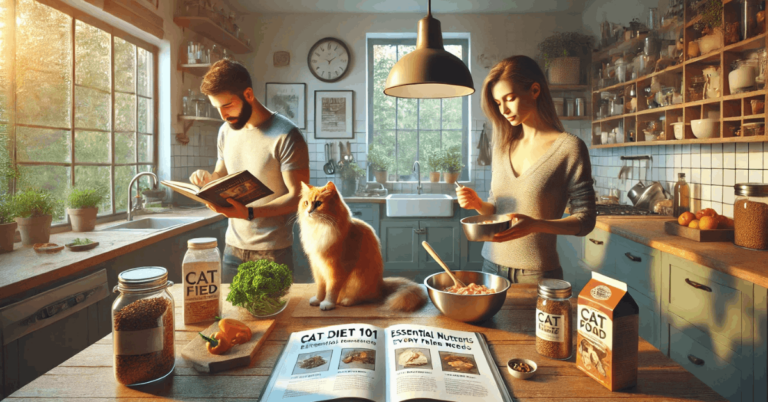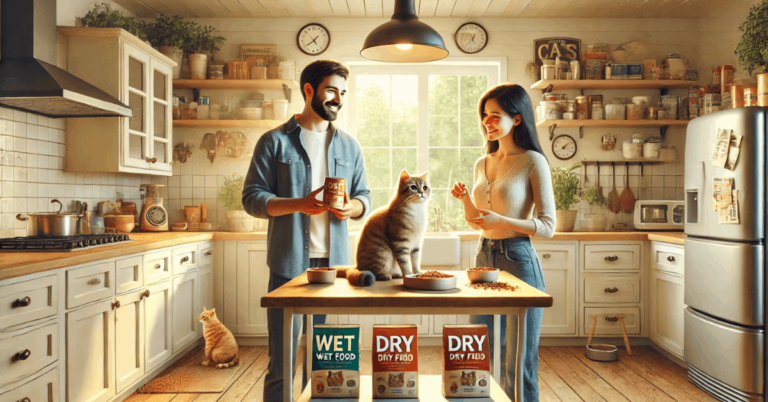A balanced diet is key to your cat’s health and long life. Cat meal plans can help manage weight and improve overall well-being.
Proper nutrition supports energy, healthy aging, and prevents common health issues. This article offers tips to create meal plans that keep your cat healthy and thriving.
Understanding Cat Nutrition
Cats need a proper diet to stay healthy and active. Good nutrition helps with energy, weight, and long-term health.
Essential Nutrients for Cats
Proteins are important for muscle and growth. Fats supply energy and keep the coat healthy.
Vitamins and minerals support the immune system and digestion. These nutrients need to be balanced for overall wellness.
Hydration and Its Role in Health
Water is essential for digestion and temperature regulation. Staying hydrated prevents kidney and urinary problems.
Wet food can increase water intake. Always offer fresh water to keep them hydrated.
Assessing Your Cat’s Dietary Needs
Every pet has unique dietary needs that change over time. Understanding these needs helps maintain a healthy weight and energy level.
Factors Influencing Dietary Needs
Your pet’s diet depends on several factors:
- Age: Kittens, adults, and seniors need different nutrients.
- Weight: Overweight or underweight pets need adjustments.
- Activity Level: Active pets burn more calories.
- Health: Conditions like allergies or diabetes impact food choices.
Checking for a Healthy Weight
Feel the ribs—they should have a thin, fat layer. Look from above for a visible waistline.
Extra fat around the belly suggests overweight issues. Consult a vet for precise guidance.
Designing a Balanced Meal Plan
A good meal plan ensures they get the right nutrients in proper amounts. Portion sizes and food frequency should match their needs.
Portion Sizes and Meal Frequency Guidelines
Consider these when planning meals:
- Age: Younger pets may need frequent meals.
- Size: Larger ones often require bigger portions.
- Type of Food: Wet food has fewer calories per gram than dry.
- Activity: Active pets need more calories than less active ones.
Comparing Wet and Dry Food
Both wet and dry food have unique benefits:
- Wet Food: Adds moisture and helps with hydration.
- Dry Food: Convenient and supports dental health.
- Combination Diet: Balances variety and nutrition.
- Storage: Dry food lasts longer, but wet food is more palatable.
Weight Management Strategies
Keeping your cat at a healthy weight is important for preventing health problems. Proper weight management combines diet and activity.
Tips for Helping Overweight Cats Lose Weight Safely
Managing weight loss should be done carefully:
- Portion Control: Measure meals and reduce treats.
- Regular Feeding Times: Keep a consistent schedule.
- Encourage Activity: Use toys or play daily.
- Choose Low-Calorie Food: Look for options labeled for weight management.
Maintaining a Healthy Weight Without Underfeeding
Balanced portions prevent undernutrition while managing weight. Feed meals based on their size, age, and activity level.
Monitor progress and adjust portions as needed. Include physical activities to burn calories and maintain fitness.
Supplements and Special Diets
Supplements can help meet specific needs like joint health or skin care. Use them when your vet recommends, especially for deficiencies.
Overusing supplements may cause imbalances, so avoid unnecessary additions. Always choose high-quality products approved for pets.
Specialized Diets for Health Issues
Special diets address conditions like diabetes or kidney disease. These foods often have controlled levels of protein, fat, or carbohydrates.
Consult a vet before switching to a medical diet. Proper care includes regular check-ups to monitor their health.
Human Foods and Their Risks
Certain human foods can cause serious health issues in pets. Knowing what’s safe helps avoid accidental poisoning.
Common Human Foods That Are Toxic to Cats
Avoid these harmful foods:
- Chocolate: Contains toxic substances like theobromine and caffeine, which can cause vomiting, diarrhea, and even heart problems in pets.
- Onions and Garlic: These foods can damage red blood cells, leading to anemia, which may result in weakness and other severe health issues.
- Grapes and Raisins: Even small amounts of these can cause kidney failure, leading to decreased appetite, vomiting, and long-term damage.
- Alcohol: Even tiny amounts can be extremely dangerous, causing vomiting, difficulty breathing, and severe central nervous system issues.
Safe and Unsafe Treats
Some treats are safe but must be given in moderation. Cooked meats without seasoning are a good option.
Avoid sugary, salty, or processed snacks. Always prioritize specially formulated pet treats to ensure safety.
Feeding Practices and Routines
A consistent feeding routine helps maintain your pet’s health and behavior. Setting proper times and places for meals creates healthy habits.
Best Practices for Feeding Times and Locations
Use these tips to improve mealtime routines:
- Set Regular Times: Feed your pet at the same times every day to create a predictable and healthy routine.
- Quiet Location: Choose a calm, quiet area without distractions where your pet can comfortably eat.
- Separate Feeding Areas: For households with multiple pets, feed each one in a different area to avoid competition or stress during mealtime.
- Clean Bowls: Wash food and water dishes thoroughly and regularly to prevent bacteria buildup and contamination.
The Importance of Consistency in Feeding Routines
Consistency in feeding builds a healthy schedule and prevents overeating. Stick to fixed portions and times to avoid weight gain.
Random feeding can lead to bad habits like begging. A steady routine supports better digestion and overall well-being.
Monitoring and Adjusting the Diet
Your pet’s diet may need changes based on age, health, or behavior. Regular observation and vet visits help maintain a balanced diet.
Signs That Your Cat’s Diet May Need Adjustments
Changes in energy levels, weight, or coat condition may signal issues. Sudden loss of appetite could mean a health problem.
Overeating or under-eating shows the current diet might not be right. Monitor stool consistency as it reflects digestive health.
Regular Check-Ups with a Vet for Dietary Management
Routine vet visits are crucial for tracking weight and nutrition. Vets can suggest special diets for medical needs or aging.
Regular check-ups help identify issues early, preventing more significant problems. Always discuss dietary changes with a professional for the best results.
Final Thoughts: Healthy Cat Meal Plans
A healthy meal plan ensures weight management and better longevity. Balanced nutrition and routines keep them in good health.
Adjust meals as they age or change activity levels. These tips for weight management & longevity help them live a happier life.


